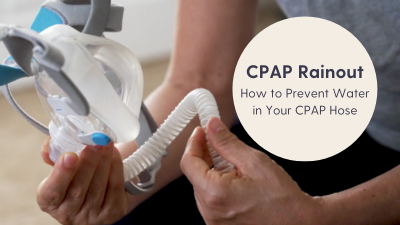
Join Our Email List!
Be the first to know about our latest special offers, promotions, company updates, and more!

If you use a humidifier with your CPAP therapy, it's likely you've noticed water in your CPAP hose or mask in the morning. Also referred to as CPAP rainout, the excess water can cause a gurgling sound in your CPAP hose or even drip onto your face during the night and wake you up. In this guide, we'll explain what causes rainout, address a common health concern with it, and offer several tips to help you prevent it in the future. Keep reading or click on one of the sections below to jump to it.
For some, the pressurized air used in CPAP therapy causes discomfort in the form of a dry mouth and nose, sinus congestion, and throat irritation. To mitigate this, many machines have a built-in chamber that can be filled with distilled water. The water is heated by the machine to humidify the air, helping you sleep more comfortably. However, it's common for the warm, humified air to cool off as it moves through your tubing to your mask. As the moisture in the air cools, it returns to a liquid state, builds up in your tubing, and drips onto your face.
While rainout can be frustrating to deal with if it causes discomfort or disrupts your sleep, it isn't dangerous. The biggest concern with rainout is the potential for it to discourage CPAP usage. While rainout may make it tempting to pull your mask off overnight, turn off humidification, or stop using your machine altogether, maintaining consistent therapy is crucial to managing sleep apnea and preventing other health issues. Fortunately, there are several effective ways to prevent CPAP rainout and continue humidified therapy.
The common theme to reduce or prevent rainout is ensuring that humidified air maintains the same temperature as it travels from your machine to your mask. Try these tips to improve your own therapy setup.
Using additional insulation and a built-in pad or coil element, heated CPAP tubing shields humidified therapy air from cooler temperatures in the room, reducing condensation buildup. Many models have sensors that detect ambient temperatures and adjust automatically, while others can be manually adjusted to find the right setting.
If you're dealing with CPAP rainout even with a heated hose, adding a CPAP hose cover to your setup could help. In addition to extra insulation that helps maintain air temperatures and prevent rainout, tube covers are made from soft, comfortable materials and can reduce airflow noise. Consider tucking your tubing under the sheets as well for an added layer of insulation.
Depending on your machine, it may be necessary to adjust humidity settings based on the season or where you live. During the spring and summer months or in warmer climates, the air coming into your machine tends to be more humid, so you might need to turn your humidity level down. Conversely, fall and winter months or places with cooler climates tend to have drier air, so you might need to turn your humidity level up. This process can take some trial and error, so we recommend talking with your doctor to help you find the right humidity setting.
The larger the temperature disparity between therapy air and your room, the more condensation you'll see in your tubing, so an effective way to reduce rainout is to increase the temperature in your room. If you can sleep comfortably, increasing the temperature a few degrees can make a difference. If you prefer sleeping in a colder room, you may want to try other rainout prevention methods first.
Aside from the potential gurgling noise, the biggest issue caused by water accumulation in your tubing is the rainout itself. If you have your machine on a bedside table and it sits at a height above your head, any water in your hose will gradually work its way down to your mask and face. Use gravity to your advantage and try moving your machine to a lower shelf or even the floor, encouraging any water buildup to flow back down the tube into the humidifier.
While no method is guaranteed to eliminate water in your CPAP hose and mask completely, using a combination of the tips above should help greatly reduce any rainout issues you're experiencing and make therapy more comfortable. If you have any questions about our heating tubing, covers, or machines, reach out to our customer service team and we'll be happy to help.